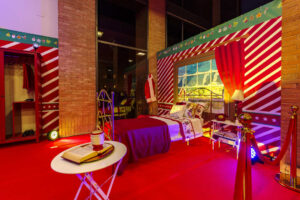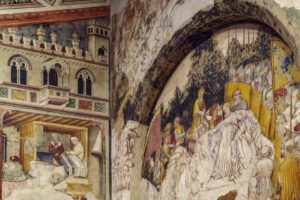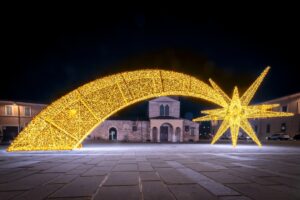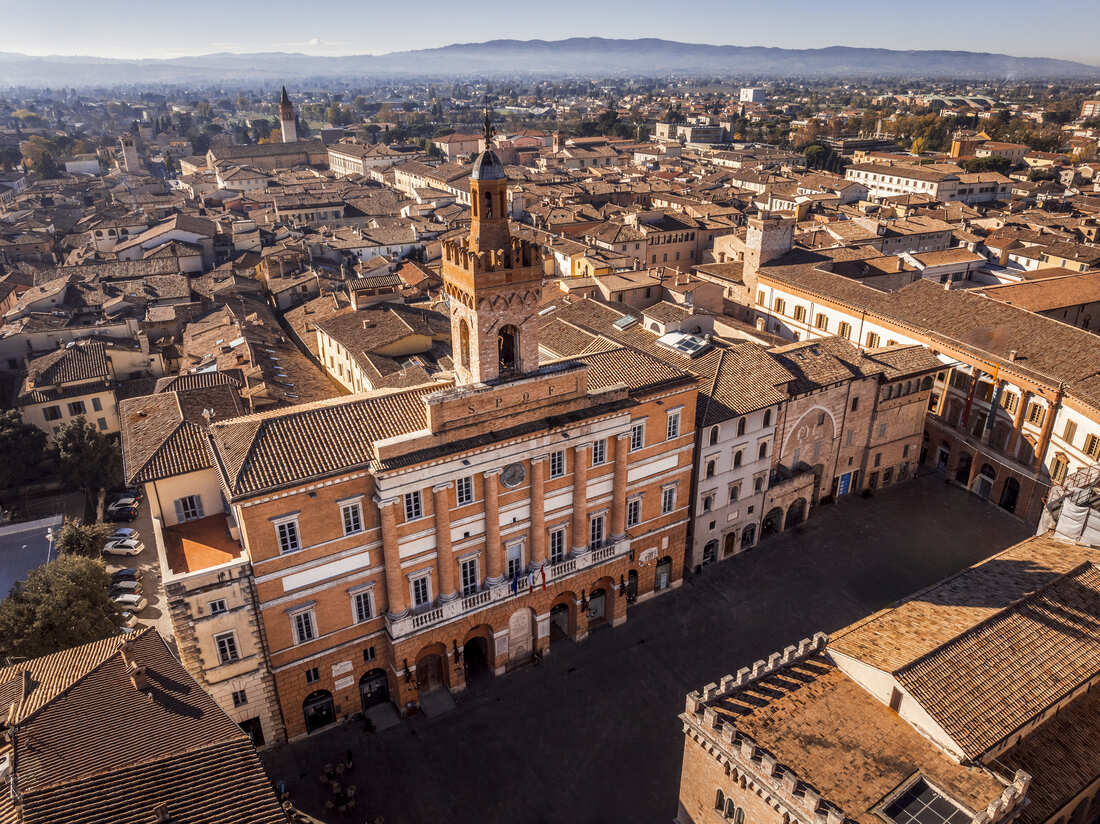By Our Editorial Staff
The city of Foligno, with its historical and artistic heritage and the numerous events that animate the historic centre, is about to immerse itself in the Christmas period with a rich calendar of initiatives that will take place from the end of November until January 11th. Lightings, street performances, music, children entertainement, exhibitions, guided tours will animate the most awaited festivities of the year.
 Santa’s House at the former Piermarini Theatre will be open until December 26 with an evocative setting, a consultation and book loan point open from the Municipal Library, workshops and shows aimed at children, which this year will have as their main theme: “Playing and games of the past”. Speaking of antique toys, a real exhibition will be set up in the Children’s Library, which for one day will also become the setting for a theatrical performance.
Santa’s House at the former Piermarini Theatre will be open until December 26 with an evocative setting, a consultation and book loan point open from the Municipal Library, workshops and shows aimed at children, which this year will have as their main theme: “Playing and games of the past”. Speaking of antique toys, a real exhibition will be set up in the Children’s Library, which for one day will also become the setting for a theatrical performance.
The same concept will guide the three urban trekking appointments, narrated and theatricalized, to discover the historic centre. For music lovers, in addition to the street band parades, the San Domenico Auditorium will host the traditional Christmas concert this year entitled “Swingin Christmas Party”. In addition, some guided tours will be offered to the most representative places of the city, including the beautiful cathedral recently restored and the Sanctuary of Santa Angela da Foligno, with the adjoining cloister and bell tower.
There will also be the New Year’s Eve event in the Square, an event much awaited by citizens and visitors.
Ideas to discover Foligno: the famous people linked to the city
If during the Christmas period there are even more reasons to visit the city, Foligno is a tourist destination that can be appreciated at any time of the year.
A different and original point of view to discover its cultural heritage is that of the many famous people to whom the city is linked, for various historical reasons. A city on the plain, central from the point of view of communication routes and dynamic from an economic perspective, home to major fairs and markets, Foligno has always attracted or hosted illustrious personalities. Let’s find out some of them through a quick overview.

Foligno is closely linked to Dante Alighieri because the first printed edition of the Divine Comedy was made here on April 11, 1472, in one of the first printing houses set up in Italy, by Johann Numeister and Emiliano Orfini. This legacy is celebrated every year in April with the Dante Days, a festival that includes conferences, exhibitions and other cultural initiatives. In addition, the city is home to the “Dante Alighieri” Municipal Library, dedicated to the poet, and the Museum of Printing, located in Palazzo Orfini, home to the ancient printing house. The museum is dedicated to the history of printing in Foligno, from the dawn to the mid-twentieth century.
Together with Dante, the other “giant” of the Italian Middle Ages, St. Francis, is also linked to Foligno.
 In 1205 Francis, after embarking on his journey of conversion, stripped himself of everything he owned in the central square of the city, including his clothes and his horse, to sell them at the fair and collect the money necessary to repair the church of San Damiano in Assisi.
In 1205 Francis, after embarking on his journey of conversion, stripped himself of everything he owned in the central square of the city, including his clothes and his horse, to sell them at the fair and collect the money necessary to repair the church of San Damiano in Assisi.
The episode is celebrated by the bronze monument created by Pietro Battoni in 2020, which depicts the hands holding out the fabrics and the horse, symbols of Francis’ renunciation of earthly goods.
The figure of St. Angela of Foligno, who lived in the second half of the thirteenth century, a Franciscan mystic and tertiary, is linked to St. Francis and Franciscan spirituality. He is a central figure in medieval spirituality and his work, the Liber de mirabilibus novae et veteris theologiae, is a fundamental text of mystical literature. The Church of San Francesco, today the Sanctuary of Santa Angela da Foligno, houses the remains of the Saint.
Another pivotal figure of the Italian Middle Ages, Emperor Frederick II of Swabia lived his very early childhood in Foligno, a Ghibelline city loyal to the imperial cause. The link with the city was maintained over time: in January 1240, Frederick II made a solemn entry into Foligno with his court, welcomed by the local nobles. On this occasion, he wrote a famous letter to the citizens, celebrating his childhood bond with the city: “In the territory of Foligno our childhood began to shine”.
A fresco by Mariano Piervittori (1884) in the council chamber of the City Hall depicts the return of Federico welcomed by the nobles of the city. A commemorative marble plaque is displayed in Piazza della Repubblica, on the “Palazzetto del Podestà”, to celebrate and strengthen the historical bond between the emperor and Foligno.
Moving forward in the centuries we arrive at the early fifteenth century, the last period of splendor of the Trinci family, a lordship that ruled the city for over a century. At that time the greatest exponent of the international Gothic style, Gentile da Fabriano, worked at Palazzo Trinci. The splendid frescoes in the Loggia of Romulus and Remus and in the Hall of Arts and Planets can still be admired today by visiting the City Museum. Gentile da Fabriano painted the frescoes for the lord Ugolino III, to celebrate the Trinci dynasty and the greatness of its dominion.

We conclude the roundup with the neoclassical era and with Giuseppe Piermarini, the famous architect originally from Foligno known above all for the Teatro alla Scala, the Royal Palace of Milan and the Royal Villa of Monza.
Piermarini was born in the Umbrian city in 1734 and died in 1808. Foligno has named several places after him, such as Piazza Piermarini and the theatre of the same name, where numerous shows took place since the beginning of the nineteenth century. Destroyed by an Allied air raid in 1943, the façade remains, visible along Corso Cavour.
Foligno still houses the birthplace of the famous architect and above all the precious collection of all his drawings, preserved at the Municipal Library and protagonists of important exhibitions, such as the one currently open to the public: “Piermarini in Milan. The drawings of Foligno“, set up at the Museum of Palazzo Trinci until 25 January 2026.


Info: Ufficio Informazioni e Accoglienza Turistica (Iat) Valle Umbra / Porta Romana, Corso Cavour 126, 06034 Foligno (Pg) / Tel 0742 354459 – 354165 / email: servizio.turismo@comune.foligno.pg.it / www.comune.foligno.pg.it/turismo/ / facebook e instagram: visit.foligno

